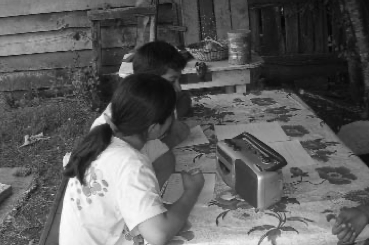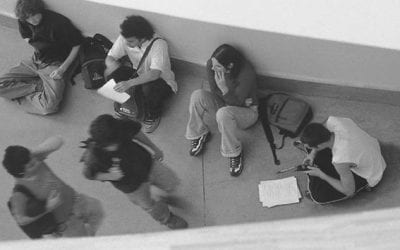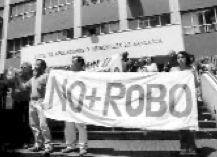The Other 9/11
My Coup Diary

Photo by Alvaro Hoppe.
Like a bolt of lightning that illuminates a darkened landscape, attracting everyone’s attention, the recent commemoration of the 30th anniversary of the military coup of 9-11-1973 has compelled Chileans to confront a traumatic history that many had preferred to ignore or “forget.” The outpouring of television specials, commemorative events and political controversy—and the flood of individual memories and battles over the collective memory that they provoked—may not have settled old debates or persuaded old antagonists. However, they did underscore that “silencio” and “olvido”—conscious “forgetting”—are no longer viable ways of dealing with this past. This is even true for foreign observers of the coup—like myself. As a result, I decided to make public my private “Coup Diary, ”published here for the first time. The diary’s particular value is that it is a first-person account by a witness who was also a trained observer acutely aware of the historical significance of the events he was witnessing. I have edited it to remove purely personal references and have added a few explanations for ReVista readers. Otherwise it is as I wrote it 30 years ago—the diary of my personal experience of that other 9/11.
Chile’s military coup brought Chile’s model democracy and President Salvador Allende’s “democratic road to socialism” to a violent end. Out of its ashes would emerge the 17-year dictatorship of General Augusto Pinochet, whose repressive politics, regressive social policy and neoliberal economics were the polar opposite of Allende’s Popular Unity government and whose gross violations of human rights would make Chile an international pariah—except in Washington. The 1973 military coup would change Chile forever, and alter the regional and hemispheric balance of power as well. It was a historical watershed of transcendent importance.
THE OTHER 9/11: A COUP DIARY
When the army tanks started firing at the presidential palace, I was standing across the Plaza de la Constitution.By then, his police guard had deserted Salvador Allende, leaving the desperate defense of his democratic road to socialism to a score of friends and associates who had chosen to remain with him in La Moneda in the face of certain defeat and probable death. I had also chosen to remain—across the plaza. I was a historian, I had reasoned, and I had to bear witness to this watershed historical event. But as the bullets started to rain down all around me, it began to look like I had made a poor choice.
It was all because I had gone to get my Chilean Resident identity card that morning. I awoke at dawn on that gray and chilly late winter day, after a night of too little sleep filled with dreams of foreboding.
I left my house early that morning to get downtown before the offices of Identificaciones opened. I had been there the Friday before to get my identity card, but so many people were on line to get their safe conducts to leave the country that I had waited in vain to be seen.
One of them was Andre Gunder Frank, the German leftist intellectual and adviser to the MIR, the activist Revolutionary Left movement, who gave me the incredulous look reserved for fools and madmen when I told him what I was there for. “Don’t you know that there is going to be a rightist military coup,” he asked pointedly. I had been told by the head of Allende’s foreign press office that it would take place on September 12th. “Yes,” I said, trying to sound brave and principled, “but I’m staying.” I was not only a historian researching a book but also a journalist with a weekly radio program from Chile on WBAI. When the doors opened on 9/11/1973, I was first on line outside the ID card office. The young woman who had not been able to attend me the Friday before smiled at me and said she would call me in five minutes. But when she returned a few minutes later it was with a worried look on her face and a hurried statement that she would not be able to process my request—nor anyone else’s—that day. Her barely-open office was about to close for the day. Something in her voice stopped me. “Why?” I asked. “Is something wrong?” Her response was so classically Chilean: “Me parece que hay un problemita en La Moneda”—“It seems as if there is a little problem at the presidential palace.”
This was it! I raced down the stairs and out the door heading for the Plaza de la Constitution. Next door to the offices ofIdentificaciones were the offices of Investigaciones, the Chilean FBI, the one security service that Allende had been able to staff with his loyalists. As I passed its doorway two detectives sprinted out carrying submachine guns and heading for a squad car. I asked them if anything had happened. One shouted over his shoulder—“No,” then paused and added: “todavía”—“not yet.”
I walked rapidly to the Foreign Press Office, which overlooked the presidential palace and the Plaza de la Constitucion. The head of the office was not there, but my friend his assistant was. I asked what was happening. “It seems that there is an uprising of the armed forces,” he replied. “All of them?” I asked. “No,” he said. “Just the army, the navy and the air force.” That was not as crazy a statement as it sounds. It meant that the Carabineros, the militarized national police, the second largest force in Chile, with bases in every city, town and hamlet in Chile, was still loyal to the Allende government. If that remained true, a resistance to the coup could be mounted. I went to the window and saw the Carabinero buses disgorging dozens of uniformed police with heavy machine guns to take up defensive positions around La Moneda, joined by tanquetas, the light tanks of the Carabineros, used to control street demonstrations.
A few minutes went by and then the telephone rang. My friend picked it up: “Si, si, si” I heard him say disconsolately. He put down the phone and turned to me. “And now the Carabineros,” he said sadly. I looked out the window and saw the tanquetasbegin to leave the square and the Carabineros pick up their machine guns and get back on their olive green buses, leaving the presidential palace all but unguarded. “Where is Allende?” I asked. “He is inside La Moneda. The president has said that he will only leave [Chile’s White House] feet first.”
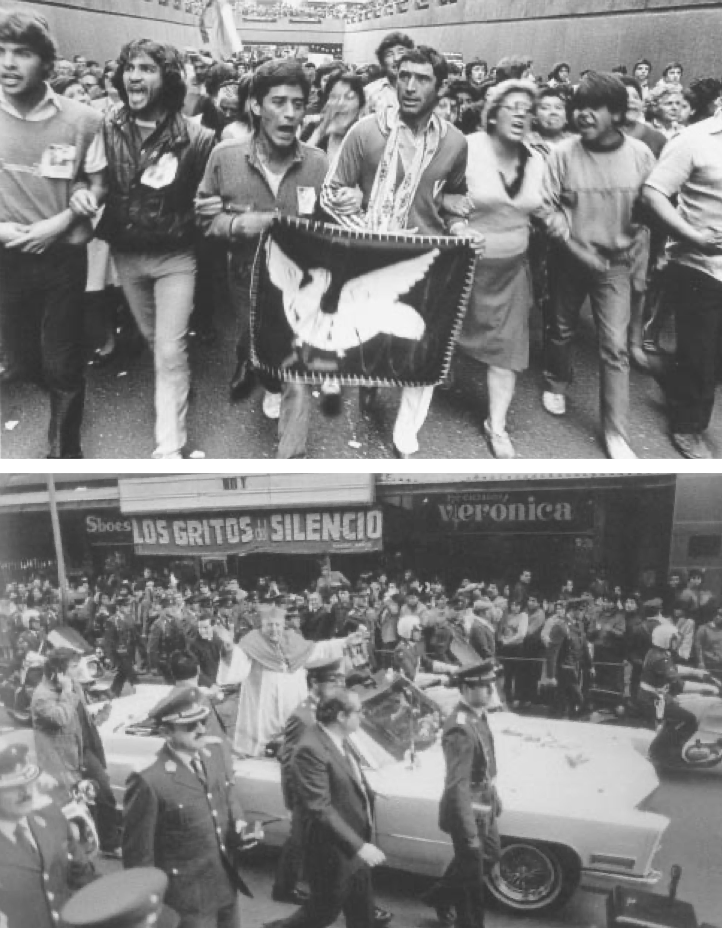
Photographs by Alvaro Hoppe.
It was just after 9 a.m. when orders came to lock up the building. I was welcome to stay if I wanted to, I was told. I debated my decision for a minute. The office had a great view of the presidential palace and the plaza in front of it. I would be able to see perfectly whatever happened.
But I remembered the Swedish photographer who was shot and killed in a similar window during the tancazo, the armored regiment mutiny of June 29, 1973. Moreover, if the coup succeeded, I would be in effect a prisoner in what its leaders would consider enemy territory. Most of all, I did not like the idea of being shut up, unable to leave no matter what happened. “Don’t fence me in,” I thought, feeling very American.
So, I thanked him and wished him luck and dashed out of the building just as its front gates were swinging shut. I decided to watch what happened from the far corner of the plaza, so that I would not have to cross an open battleground to “retreat” towards my apartment building roughly a mile away. It was 9:30 and there was a small crowd of people, most of them workers from suddenly closed government offices, milling around in the street. Most of them were Allende supporters hoping for loyal troops who would rescue the government, as had happened in the tancazo two months before.
Suddenly Carabineros arrived and began to push the crowd back from the square. I took out my journalist credentials and tried to talk with them, but the look of rage with which they regarded me—and the civilians around me—stopped me. “This is going to be a very different coup than people expected,” I thought.
A little before 10 a.m. army tanks suddenly arrived in front of La Moneda. One took up position at the corner of the square near us, its gun turret facing away from the presidential palace. The crowd cheered, thinking that it was there to defend Allende. Then, slowly, ever so slowly, its gun turret wheeled and aimed at the presidential palace. There was first stunned silence and then an audible gasp, as the enormity of this act became clear.
We were standing near a shopping arcade. The Carabineros told everyone to go into the arcade, whose gates would be pulled shut and locked. There we would be safe from the fighting, they explained. I considered it but rejected the image. It looked too much like being shut up in a jail. I decided to take my chances out on the street. Weeks later I learned that after the coup, people inside the arcade were taken to the National Stadium for interrogation. Some of them disappeared forever.
A few minutes after ten, however, it looked like a bad decision. The tanks started firing at La Moneda. Suddenly bullets were everywhere, raining down from the government office buildings where the Socialist Youth were posted as snipers to defend the presidential palace. My corner was soon an untenable observation post. There were people falling wounded around me. Hugging the walls, I made my way back down the street (Morande) to the next doorway, where I took refuge behind its Neo-Classical columns, newly grateful for the Chilean elite’s Europhile pretensions. In back of me, the tanks and machine guns were firing away, and in front of me the street was alive with sniper bullets. There was no escape. Opposite were the offices of El Mercurio, the leading rightist newspaper. From its second floor window a telescopic sight suddenly appeared pointing at me. There was nowhere for me to hide. If it was a gun, I was dead. I watched transfixed as the sight slowly swiveled and faced the presidential palace, revealing a camera with a long telephoto lens. I breathed a sigh of relief.
Then the firing stopped, as suddenly as it had begun. People came out from their hiding places, at first gingerly and then with greater confidence, as if it was all over. It was a symbolic corner, with the Congress building and the Supreme Court. They gathered in between these two symbols of Chile’s constitutional democracy and—as it was still Allende’s Chile—they began to argue: Who was responsible? “It was the Left.” “It was the Right.” “It was the Center.” “It was the United States.” I listened with a sense of prophetic nostalgia, thinking to myself: “This is the last public political debate that you will witness in Chile for a very long time.” But I also noticed that the discussion was getting more and more acrimonious. Then, just when I thought it would come to blows—itself emblematic of the political polarization in Chile by 9/11/73—the firing started again, sending the antagonists scurrying in search of shelter. Ironically, they took refuge under the newspapers and magazines representing Left, Right and Center hanging down from the newspaper kiosk at the corner, itself a symbol of the political pluralism and free press that was about to disappear from Chile, along with its democratic constitution, its Congress and its independent courts.
The bullets were all around me now. A man standing next to me got hit and I decided it was time to leave. I began to run down Morandé, along the side of the Congress, when suddenly I was stopped by what seemed to be a red puddle in the middle of the street—it was a pool of blood. I gasped and began to run again, faster this time. As I passed the street where the headquarters of the Communist party and the labor confederation were located, I saw the Carabinero tanquetas firing away. Shots rang out near me and a tanqueta wheeled and began to fire in my direction. I ducked around the corner and kept running until I reached the old market close to the river. As I emerged from behind an overturned fruit cart, I saw them: all along the broad boulevard of the Parque Forestal along the River Mapocho was the army.
Two regiments were drawn up—the Buin and the Tacna—with tanks and machine guns and coded color armbands. The soldiers seemed very young, conscripts of 17 or 18 –and they were very nervous. If I had been afraid that the Carabineros near the Plaza would kill me out of rage, here I was concerned that they could kill me out of nervousness and inexperience.
They were herding civilians across the river, outside of their battle station perimeter. I crossed the bridge near the Mapocho railway station, and turned east toward my apartment. More and more people were crowding the Costanera, the road running along the river, as buses were stopped and their riders were forced into the street at gunpoint, many of them with their hands over their heads out of fear, like refugees from some war movie. Manicured men in business suits were thrown together with down-and-out beggars, housewives and street vendors.
But, for the first time, the firing seemed distant. I stopped to rest and looked back across the river toward the downtown battle zone that I had just escaped. Someone had a transistor radio tuned to the military warning that they would bomb the presidential palace if Allende would not surrender. In his final speech, the best of his long political career, he insisted that he would not surrender—“Pagaré con mi vida la lealtad del pueblo”—“I will pay with my life for the loyalty of the people.” The young woman next to me began to cry. I assumed that she was an Allende supporter, but I was mistaken. She was mostly apolitical, she explained, but leaning toward the Right. She had voted for the rightist candidate Jorge Alessandri in 1970 and said to me: “Two days before I would have been happy to see Allende hanging from a lamppost, but this—”the Chilean military attacking the presidential palace, the symbol of Chilean democracy, this should not happen. This is not the Chilean way.” The sky was getting darker,with a hint of rain. ”El cielo no querría ver lo que pasará,“—Heaven doesn’t want to see what is going to happen,” she concluded.
I decided that I had to return to my apartment while I still could. I asked a young soldier where I could cross. He motioned to a bridge upriver near Calle Estados Unidos. It took me past the old U.S. Consulate—the only foreign consulate not to offer refuge or help during the coup even to its own citizens, one of whom, Charles Hormon, would be detained and executed as a consequence: later to become the story of the Academy Award-winning film Missing. I headed down a little side street toward my apartment in the Torres San Borja opposite what would become the headquarters of the military regime.
I passed a group of worried but determined men coming out of a doorway with a Socialist Party banner. Two of them had pistols tucked into their belts. I overheard them making plans for what they would do when the troops arrived. I stole a last glance at their tense, sad faces, at a determination born more out of desperation than optimism. They would fight, but they knew that it would be a futile if heroic last stand. Their pistols would be no match for the tanks and machine guns and rifles that I had just escaped from.
I turned the corner toward the Alameda Bernardo O’Higgins, Santiago’s central boulevard, passing by the headquarters of the neofascist Patria y Libertad and the Communist “Comité de Pobladores Sin Casa” [Committee of the Homeless]—opposite poles of a Chilean pluralism that was about to disappear. I expected sniper fire, but there was none. The Alameda, normally a raucous river of traffic, was empty and silent.
I made it to my building and took the elevator to my apartment on the 19th floor, finally safe, a privileged foreigner in a country with no personal security. I turned on the radio in time to hear the final threat to bomb the presidential palace. I got my camera out and began to track the Hawker Hunter jets streaking toward La Moneda with my telephoto lens, wishing it was a telescopic site instead, squeezing the trigger over and over again, but to no avail. In the near distance I heard the sound of the impact of their rockets. From the window I could see flames and black smoke billowing from the presidential palace.
I took out my tape recorder and began to record the military announcements. There would be an indefinite curfew…Then came the shock: a list of leftist leaders who had to turn themselves in to the nearest military post or police station. It was a strange list, including many people I knew who were moderates in the Allende government, people such as Mining Minister Sergio Bitar who posed no threat to the military coup. This list was followed by another, a list of foreigners who were also to turn themselves in at once. Andre Gunder Frank’s name was on the list. I breathed a silent prayer that he had left the country in time. Then, in a moment of terror, I suddenly realized that if other innocuous people were on the wanted list, mine might be there too….I might not be safe after all….It was a terrifying realization which brought home to me the new Chile that was about to be born.
Phone calls began to come in, from friends and Chileans who saw me as a foreign journalist who could get the word out. “Not to despair…loyal troops were on the way”… recently retired “General Prats was leading them”….“loyal provincial commanders in the north were still holding out”—all of them false rumors or wishful thinking. There would be no loyal commanders and Prats would be assassinated in his Argentine asylum by the long arm of Pinochet’s Gestapo, the DINA. As part of Operation Condor, the secret alliance of Southern Cone security services which spread terror throughout the region, even assassinating a former Allende ambassador in downtown Washington.
By nightfall, phone calls brought truer but grimmer tidings: Allende’s death in the ruins of La Moneda, the triumph of the coup throughout the country. Outside my window, fighting continued. The city was blacked out, and from my window high over Santiago, I could see the helicopter gunships home in on leftist factories and shantytowns, a horrific light show of headlights and tracer bullets illuminating the darkened city sky. I slept fitfully, awakened at 4 a.m. by a loud bomb explosion. In the distance something large was on fire. I couldn’t sleep.
The firing went on all the following day, along with reports of the targets attacked— the Pedagogico, the University of Chile’s education school, the Sumar textile factory and the nearby slum of La Legua; the working class districts of San Miguel, the “Red County” to the south of the city; the shantytowns near the foothills of the Andes to the east. That night the armed forces commanders, the new Junta de Gobierno, appeared on television for the first time. Each one addressed the nation in turn. Pinochet was the most enigmatic, terse and anti-Marxist, but vague, as if he hadn’t thought about what he would say or wanted to do. The scariest was the air force commander Gustavo Leigh, who talked of the struggle to “excise the Marxist cancer” from the Chilean body politick and of the need to reverse the preceding 50 years of Chilean history. That included not just the three years of Allende’s road to socialism, but also the Alliance for Progress reforms of the Christian Democratic government of the 1960s, the welfare state and labor reforms of the Popular Front of the 1930s, even Arturo Alessandri’s introduction of mass democratic politics of the 1920s. Clearly this was not going to be a “soft coup,” a brief period of military rule to calm things down and then return power to the civilian political leaders as in past military interventions. Later that night I was awakened by the sound of animals roaring in agony. It was the lions in the zoo across the river, who had not been fed for two days. It seemed to me that they were expressing what too many Chileans felt that night, that they were symbolic of a nation in agony….
The curfew ended at noon on Thursday, September 13th… I emerged from my building into a new Chile, with buildings pockmarked by bullets and people viewing each other with unease. On this incongruously sunny and beautiful day, I walked up to Avenue Vicuña Mackenna and past the Argentine embassy. It was surrounded by a Chilean army platoon, rifles at the ready. In front of its gates was a military pickup truck. Inside it was a tall, thin intellectual with thick glasses. He was on his knees with his hands tied behind his head and a bayonet sticking into his back. Next to the truck was a young woman looking distraught but impotent. Was he one of those named in the most wanted list? Or was he just a Chilean or foreign leftist intellectual who had tried to reach an embassy asylum but failed to make it?
I stopped to stare, but a soldier raised his rifle and started to point it at me, so I walked on.
I walked through the Plaza Italia, the midpoint of Santiago, which was under military surveillance, and thought of crossing the Mapocho to Bellavista, to retrace my steps of two days before. Then, as I approached the river bank, I froze in horror. In the shallow waters were the bloated bodies of young men, whose clothes identified them as pobladores, poor residents of the shantytowns upriver. Most had multiple bullet wounds. There were soldiers on the Pio Nono bridge eyeing me. I turned on my heel and hurried away. This was not only a very different coup than most Chileans had anticipated, but it would be a very different military government from the dictablanda, soft dictatorship—they had expected as well.
I walked down the Alameda’s broad boulevard to the newspaper kiosk where in the past I always bought the complete array of newspapers and magazines from right to left. There was a long line of people waiting to buy the only two newspapers now permitted—censored versions of El Mercurio and La Tercera, a centrist tabloid. When I got to the front of the line, the newsvendor greeted me as a long lost friend. “I am glad you are all right,” he said knowingly. A thought occurred to me: those now banned pre-coup publications were historic documents. I asked him if he still had any of the old newspapers and magazines and if he could sell them to me.
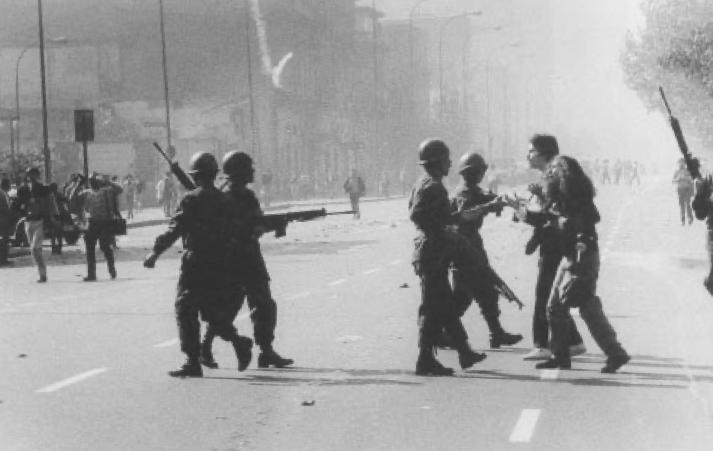
Photo by Alvaro Hoppe.
He reached under the counter and pulled out a stack and handed them to me. “Take them,” he said. “No charge. Just takethem.” I was gathering up my stash of now historical publications when the man in back of me tapped me on the shoulder. He had a goatee and an intellectual manner and pointed down the street at the hurrying figure of an air force junior officer who had been on line as well. The officer had gone to report me to the nearest patrol, he warned. I had better get out of there fast. Hiding my newly “subversive” literature inside my censored official publications I walked away, at first slowly, then faster and faster.
By the time I turned the corner I was running, looking over my shoulder to see if anyone was following me. It was far more terrifying than the hour of bullets and neardeath experiences that I had had to endure during the coup itself—an ominous harbinger of the dictatorship to come. I made it to my building, locked the door of my apartment and collapsed in a cold sweat. The street chant of Allende’s Rightist opposition–“Chile es y será un país en libertad”—“Chile is and will be a country in liberty”—echoed ironically through my mind.
I sat down and wrote in my diary: “It is very hard to learn how not to be free.”
It is a lesson that Chileans learned the hard way, during Pinochet’s brutal 17-year dictatorship.
It is a lesson that they are still struggling to unlearn today.
Spring 2004, Volume III, Number 3
Peter Winn is a professor of history and director of Latin American Studies at Tufts University. He is the author of Weavers of Revolution, an oral history of Allende’s Chile, and editor of Victims of the Chilean Miracle: Workers and Neoliberalism in the Pinochet Era.
Related Articles
Thinking on Children: A Literary Look at Childhood
When William Wordsworth formulated this reversal of parenting, putting children first and parents later, he followed through on a romantic inspiration about innocence being close to…
Salamanca of the Southern Cone
A few decades ago, Chile was commonly perceived as a long, earthquake-prone country in South America with a tough human rights record that made even intrepid travelers wary. Today…
Politics and Corruption
Since the beginning of Chilean redemocratization in 1989, numerous allegations of corruption in local government, the judiciary, ministries, public services and public enterprises have impacted…

